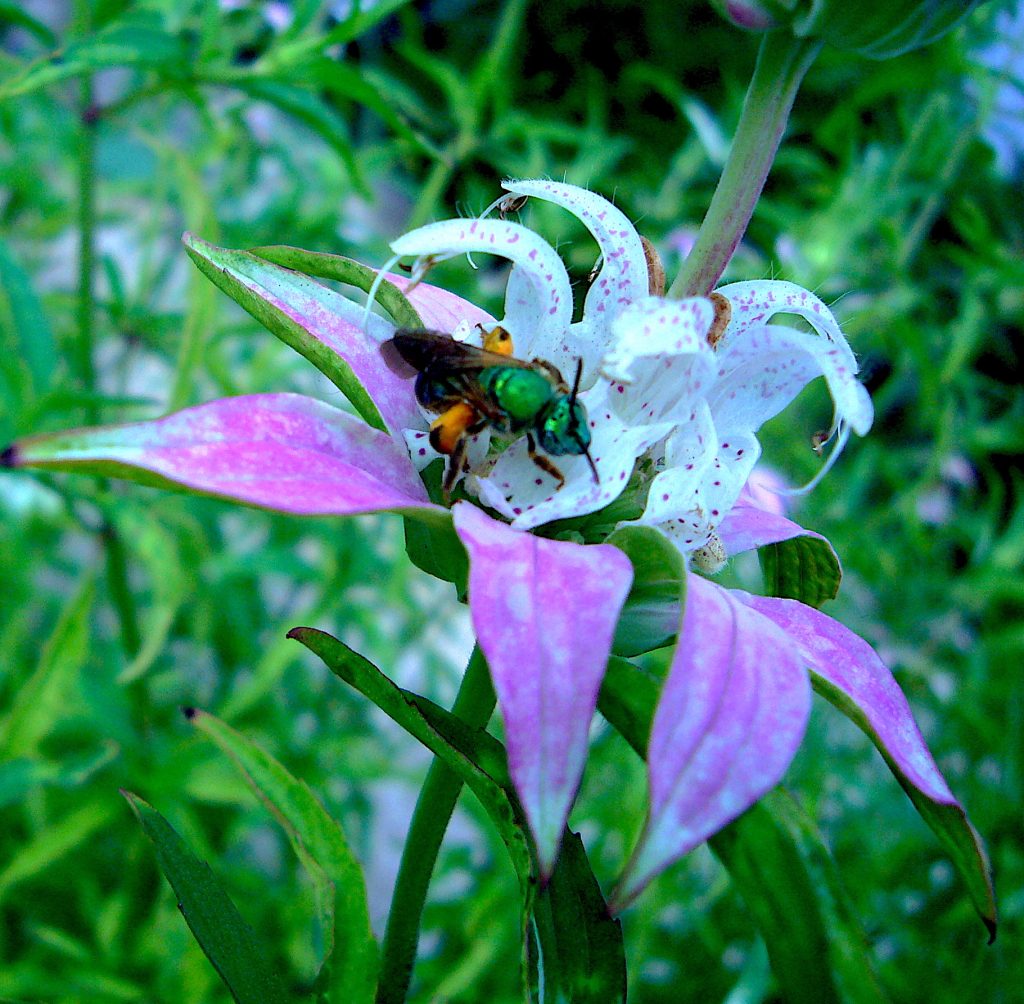
Monarda punctata, Horsemint, Beebalm. Photo by Green Deane
We’ve mentioned it a few times in recent newsletters but it bares repeating: Horsemint — see above — is in season and very easy to find now. Look in grassy sandy places or along paths in always dry areas. The pleasant side of the plant is that it smells nice and makes a Thyme-like spice. The naughty side of the species is that it contains Thymol which is a relaxant. Made into a tea it calms you down. How much it calms you down depends on how much you use and your personal response to it. You can also hang some in your house as an air freshener. You can read about Horsemint here.
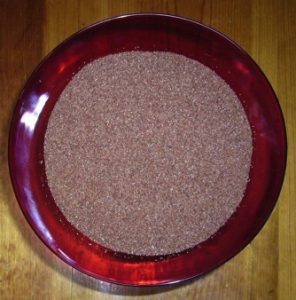
Crowfoot Grass seeds are gluten free. Photo by Green Deane
Crowfoot Grass, which is ripening now, is not native to North America. It’s from Africa where the species is used to make unleavened bread and a frothy beer. While crowfoot grass is easy to harvest — when ripe — the grains are tiny, eye of a needle size. You can collect about two quarts an hour — making them calorie positive — and they can grow in large colonies making harvesting easy. Usually you collect the grains while sitting and using window screen plastic as a strainer. The grains have a small amount of cyanide in them but drying and cooking drives that off. Though minute botanically they are a mouthful: Dactyloctenium aegyptium. That means ‘little comb fingers from Egypt.’ You can find Crowfoot Grass from Maine to California skipping the upper northwest side of the country.
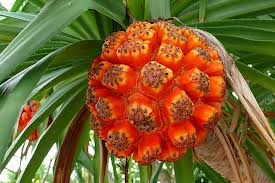
Pandanus Fruit, also called screw pine because it twists as it grows.
The question every time you see one — left — is which species is it? There are some 600 of them in the genus and several are edible one way or another. The one to the left is in Dreher Park. Sometimes it has a little bit of calcium oxalate in the fruit and sometimes doesn’t. So one has to taste it carefully. What you do is take a section, which is a cluster of smaller parts, and chew it. The goal is to get the juice out of it more than anything else though some pulp is edible. Last year this particular growth lightly burned my lips enough to notice but not bothersome. The young white base of the fronds are also edible Three species are commonly known as edible: Pandamus amaryllifolius, Pandanus fascicularis, and Pandanus tectorius. The latter is the most consumed of all and would be a good find. One of the more interesting things about the Pandanus is how it burns when lit. A dried Pandanus stalk can smolder for days like a baseball bat-sized cigarette. It was how some of the Aboriginals of Australia carried fire from one place to another. Among other speces we can find in Dreher Park in the park are Coco-plums and Simpson Stoppers asl well as Java Plums. The Sea-grapes were still green. They ripen around the first of September. The Mahoes were not yet in blossom. They are unusual in that their blossom is yellow in the morning then turn red in the afternoon. Botanist tell us that is to attract different pollinators. The blossoms also have more antioxidants in the afternoon.
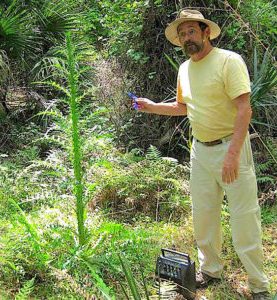
Foraging classes are held rain or shine, heat or cold. Photo by Nermina Krenata
Foraging Classes: My deceased Miata has been replace and I’m on the road again.
Sept 23rd, Bayshore Live Oak Park, Bayshore Drive. Port Charlotte. Meet at the parking lot at Ganyard and Bayshore, 9 a.m.
Sept 24th Eagle Park Lake, 1800 Keene Road, Largo, FL 33771. 9 a.m. Meet at the pavilion near the Dog Park
Sept. 30th Florida State College, south campus, 11901 Beach Blvd., Jacksonville, 32246. 9 a.m. We meet at Building A next to the administration parking lot.
Oct 1st Mead Garden: 1500 S. Denning Dr., Winter Park, FL 32789. Meet at the bathrooms, 9 a.m.
Oct 7th Boulware Springs Park, 3420 SE 15th St., Gainesville, FL 32641. 9 a.m. Meet at the pavilion near the pump house
Oct 8th Red Bug Slough , Sarasota. 9 a.m. Because of rennovations, we have to meet at a different location at Red Bug Slough in Sarasoata. Normally it is at 5200 S. Beneva Road. Instead we will have to park at Gypsy Street and South Lockwood Ridge Road. Gypsy can be reached by Camphor Ave which runs south of Proctor west of Beneva.
Oct 14th Dreher Park, 1200 Southern Blvd., West Palm Beach, 33405, 9 a.m. meet just north of the science center.
Oct 15th Blanchard Park, 2451 Dean Rd, Union Park, FL 32817 9.a.m. met at the pavilion by the tennis courts
For more information, the pre-pay for a class, or sign up go here.
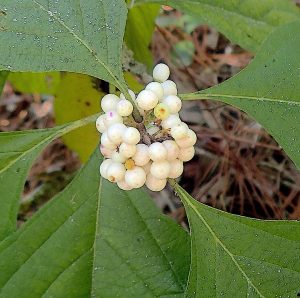
White Beautyberries. Photo by Green Deane
Are the berries to the left edible or not? Ninety-nine plus percent of white berries are not edible. White berries are a huge warning flag saying stay away. But there are exceptions. I can think of a few wild white berry species in the world that are edible, some in North America and one in Africa. But what of the berries pictured left? They are white American Beautyberries. Usually they are magenta when ripe. These are stark white. I have eaten a few. They taste like the colored ones. A few years ago I had a woman in New Jersey write to me and report she eats them all the time and makes jelly out of them. That’s not an official endorsement but it is about as close as one can get to knowing if they are edible. There are at least four species of Beautyberries that can spontaneously produce white berries, and there might be a man-made cultivar or two. The shrub at left had magenta colored berries for several years then went one for one year then back to colored berries. To read more about them click here.

The nose doesn’t always know.
The aroma of a wild food is the most flexible of all descriptions. This is for two reasons: Noses differ and plants differ. Taste is also quite flexible but aroma variations beat taste out. When you read in a foraging guide, or even in my articles, that a plant smells like such-and-such know that the description is quite subjective. There are several local species that elicit different descriptions even when noses are whiffing the same sample. One low-growing fruit — the Gopher Apple — has been described as smelling like pink bubble gum, a new plastic shower curtain, or no aroma at all. The smelly spice Epazote ranges in opinions from citrusy to floor varnish to industrial cleaner. Even among non-edibles the olfactory estimations can vary such as with the toxic Laurel Cherry. Some think its cyanide smells like almonds, other think they smell maraschino cherries, some can’t smell the cyanide at all (it depends on your genes.) In guide books a reported aroma is just that, a guide. It is not always for certain by any means. There’s room for aromatic latitude.

Carl Linnaeus had a dirty mind.
Plant Pronunciations: What’s really important is knowing the plant and whether you can eat it or not. What you call it is secondary. Common names are okay as long as you know many plants can have the same common name. “Indian Potato” comes to mind. There are two problems with common names. You and someone else could be talking about the “Indian Potato” but actually be talking about two different species. Also every plant — in theory — has one botanical name but can have virtually dozens of common names. Many times it is just easier to remember the one botanical name. Dead Latin was chosen for the naming plants because … well… it’s dead, non-changing, non-evolving. Perhaps it was also chosen by academics as a way to keep Latin from disappearing completely. Another possibility was they wanted to use naughty descriptions and if in Latin most wouldn’t know how lewd some names are. But know even when Latin was spoken it had regional accents and far flung Latin became French, Spanish, Portuguese and Romanian. At home it became Italian. There is no etched-in-granite correct way to pronounce botanical names. Hmmmm…. take Vagus. It can be said like the city, Los Vegas, or vah-GOOSE. It means literally “wandering.” And of course there are different pronunciations botanical names in American English vs British English such as with the pine genus (PINE-us, vs. PEEN-iss.)
Many “Latin” plant names are mangled Greek. Take the genus Dioscorea, the true yams. Dead Latin has it dye-oh-SCORE-ree-ah. That makes my ears hurt. It’s named after a Greek physician, Dioscorides, 40-90 AD. So I prefer thee-oh-score-REE-dez which closer to the Greek way of saying it. The only time the botanical name is truly important is to make sure the two of you are discussing the same plant. This happened recently when I received an email from Singapore about how to use the Skunk Vine. There are several Skunk Vines (like Indian Potatoes, Hog Plums et cetera.) As we were exchanging information about Paederia foetida without the botanical name that would have been difficult. Scientific names of any species can be a personal hurdle. And some times you don’t have a choice. The majority of mushrooms do not have a common names. You just have to bite the Boletus.

You get the USB, not the key.
150-video USB would be a good end of spring present and is now $99. My nine-DVD set of 135 videos has been phased out. The USB videos are the same videos I have on You Tube. Some people like to have their own copy. The USB videos have to be copied to your computer to play. If you want to order the USB go to the DVD/USB order button on the top right of this page. That will take you to an order form. I’d like to thank all of you who ordered the DVD set over the years which required me to burn over 5,000 DVDs individually.

Green Deane Forum
Want to identify a plant? Perhaps you’re looking for a foraging reference? You might have a UFO, an Unidentified Flowering Object, you want identified. On the Green Deane Forum we — including Green Deane and others from around the world — chat about foraging all year. And it’s not just about warm-weather plants or just North American flora. Many nations share common weeds so there’s a lot to talk. There’s also more than weeds. The reference section has information for foraging around the world. There are also articles on food preservation, and forgotten skills from making bows to fermenting food.
 Now being printed is EatTheWeeds, the book. It should have 275 plants, 350-plus pages, index and color photos. Several hundred have been preordered on Amazon. And it is being printed as I write. Most of the entries include a nutritional profile. Officially it will be published Dec. 5th (to suit the publisher publicity demands) apparently to appeal to the winter market.
Now being printed is EatTheWeeds, the book. It should have 275 plants, 350-plus pages, index and color photos. Several hundred have been preordered on Amazon. And it is being printed as I write. Most of the entries include a nutritional profile. Officially it will be published Dec. 5th (to suit the publisher publicity demands) apparently to appeal to the winter market.
This is weekly newsletter #573. If you want to subscribe to this free newsletter you can find the sign-up form in the menu at the top of the page.
To donate to the Green Deane Newsletter click here.


